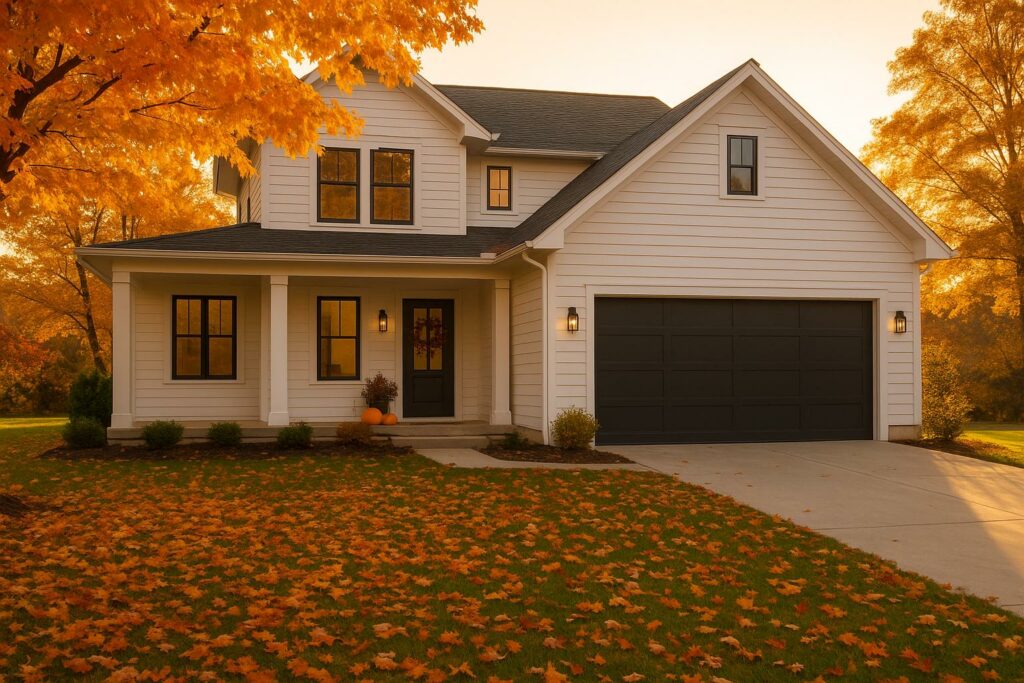Seasonal changes can make or break real estate photography. Each season offers unique lighting, colors, and challenges that can influence how buyers perceive a property. Here’s why tailoring your photography by season matters:
- Spring: Soft light and blooming greenery make properties look fresh and inviting.
- Summer: Long days and vibrant colors create stunning visuals, but avoid harsh midday sunlight.
- Autumn: Warm golden tones and fall foliage add depth and charm to photos.
- Winter: Crisp light and cozy indoor settings highlight comfort but require careful lighting adjustments.
Key Stats:
- Homes sell 16% higher in June than in winter.
- Listings with professional photos get 118% more views and sell 32% faster.
- 66% of buyers say photos are "very useful" when evaluating properties.
Using professional services like HDR photography, drone shots, and virtual staging can help you navigate seasonal challenges and make your listings stand out year-round.
Visual Storytelling in Real Estate: The Power of Seasonal Property Photography
How Seasons Change Lighting and Color
Natural lighting shifts throughout the year, creating unique opportunities and challenges for real estate photography. By recognizing these seasonal changes, photographers can work with nature to present properties in their best light. Here’s how each season influences lighting and color, and how photographers can adapt.
Spring: Soft Light and Fresh Growth
Spring brings a mix of soft, warm light thanks to the sun’s moderate angle, making it ideal for capturing both interiors and exteriors. The season’s green lawns, blooming flowers, and budding trees add a fresh, well-kept look to properties. Even overcast days can work in a photographer’s favor, as clouds act like natural diffusers, softening shadows and highlighting architectural details.
Summer: Long Days and Vibrant Colors
Summer offers long daylight hours, making scheduling more flexible. However, the intense sunlight during midday can pose challenges. Photographers often shoot during the golden hours – early morning or late afternoon – to capture softer, more flattering light. The season’s vivid blue skies, lush greenery, and colorful flowers create stunning backdrops. To manage harsh shadows and balance the brightness, reflectors and careful timing are essential.
Autumn: Warm Light and Rich Hues
Autumn stands out for its warm, golden light, which creates a welcoming and cozy atmosphere. The vibrant fall foliage – reds, oranges, and yellows – adds depth and visual interest to property photos. With the sun lower in the sky, the golden hour lasts longer, providing more time to shoot in optimal lighting. However, fallen leaves and bare branches require thoughtful staging to ensure pathways and property features remain clean and appealing.
Winter: Crisp Light and Snowy Scenes
Winter comes with its own set of challenges, including shorter days and low-angle sunlight. Shooting near midday maximizes natural light, while artificial lighting helps brighten interiors. Snowy landscapes can be visually striking but require careful exposure adjustments to capture details without overexposing the snow. Photographers often highlight cozy interior features, such as fireplaces and warm lighting, to create inviting images during the colder months.
Preparing Properties for Each Season
By adjusting to seasonal lighting and colors, tailored staging can enhance a property’s appeal and make it shine in photographs. Each season offers a chance to highlight unique features and create emotional connections with potential buyers. Proper preparation ensures homes look their best no matter when they hit the market.
Spring: Highlight Landscaping and Gardens
Spring’s gentle light is perfect for showcasing outdoor spaces and fresh starts. Clear away winter debris, trim hedges, and plant flowers or add potted plants to bring vibrant color to the property.
Stage outdoor areas to help buyers imagine themselves enjoying the season. Arrange cozy seating with outdoor furniture – perhaps a small table set for coffee in the morning. If vehicles don’t fit in the garage, park them away from the house to keep the focus on the landscaping.
Inside, use fresh flowers and pastel accents like soft greens, pale blues, and light yellows to create a seamless connection between indoor and outdoor spaces.
Summer: Highlight Outdoor Living
With summer’s extended daylight, it’s time to emphasize outdoor living and entertainment spaces. Clean decks, patios, and walkways to remove any lingering grime, and consider refreshing wooden decks if they look worn.
Define outdoor spaces with purpose. Arrange furniture to create dining areas or conversational nooks, using outdoor rugs to visually separate spaces.
"Make sure your patios, decks, and balconies are staged with intention. A couple of well-placed chairs, an outdoor rug, and some greenery can transform a bare space into a potential buyer’s favorite room." – Meridith Baer, Interior Designer, Founder of Meridith Baer Home
Add vibrant touches with colorful throw pillows, decorative pots filled with plants, and outdoor lighting like lanterns or string lights. Shade options like umbrellas or sunshades show how the space stays comfortable during hot days. Keep lawns lush, flower beds trimmed, and consider a small herb garden to showcase the yard’s potential.
Autumn: Create a Cozy Indoor Atmosphere
Autumn’s warm light calls for creating inviting interiors that contrast with the cooler outdoor weather. Use warm lighting from table lamps, floor lamps, or overhead fixtures to give rooms a welcoming glow.
Stage fireplaces with neatly arranged logs to evoke warmth, and complement the space with seasonal touches like throw blankets, deep orange and brown accents, and subtle wreaths. Unlit candles can also add to the cozy feel.
Outside, keep walkways clear of fallen leaves for a neat appearance. Add a seasonal wreath to the front door or a winter plant arrangement to enhance curb appeal.
Winter: Emphasize Warmth and Accessibility
In winter, shorter days and crisp light make safety and warmth key priorities. Keep walkways clear of snow and ice, using salt or sand for traction, and remove any hazardous icicles.
Indoors, focus on creating a warm and inviting atmosphere. Ensure heating systems are working efficiently and set to a comfortable level. Light fireplaces where possible and use warm-toned lighting to brighten up darker spaces.
Add cozy details to help buyers picture themselves living comfortably. Thick throw blankets, warm-toned pillows, and touches like a hot cocoa setup on the kitchen counter can make a big impact. Subtle winter decor, such as an elegant wreath or seasonal arrangements, ties the space to the season while maintaining a welcoming look year-round.
sbb-itb-82c5f45
Working with Weather Conditions
Weather plays a key role in shaping the natural light and overall mood of property photos. Knowing how different conditions affect your shots can help you capture images that stand out. Let’s break down how clear skies and cloud cover influence your photography.
Clear vs. Cloudy Days
Choosing between clear and cloudy weather comes down to understanding their unique strengths and challenges. Both offer opportunities to create visually appealing property images, but each requires a different approach.
| Weather Condition | Pros | Cons |
|---|---|---|
| Cloudy | Soft, even light; true-to-life colors; no harsh glare | Flat appearance; dull skies may need editing |
| Sunny | Bright, vibrant colors; dramatic shadows; golden hour adds warmth | Harsh shadows; glare issues; tricky exposure settings |
On sunny days, colors appear richer, and the added depth from shadows can make images more dynamic, especially during golden hours. However, harsh sunlight can create strong shadows and glare, requiring careful adjustments to your camera’s settings.
Cloudy days, on the other hand, provide soft, even lighting that’s especially useful for interior shots. This lighting minimizes shadows and ensures accurate color representation. However, exterior shots might lack vibrancy and often need post-editing to enhance the sky or overall tone.
Photographing in Rain and Snow
Rain and snow, while sometimes challenging, can add a unique flair to property images when handled correctly.
Rain Photography
Rainy conditions can bring out rich, saturated colors and create captivating reflections on wet surfaces. To make the most of these opportunities, protect your gear with rain covers, plastic bags, or umbrellas. For interior shots on rainy days, use flash to brighten the space and focus on cozy elements like fireplaces or warm lighting to create an inviting feel. Reflections on windows can be minimized by closing curtains or editing the sky in post-production to maintain a clean look.
Snow Photography
Snow presents its own set of challenges and opportunities. Before shooting, clear pathways and driveways to ensure safety and highlight good property upkeep. Snow naturally reflects light, providing soft illumination, but it can also trick your camera into underexposing photos. Adjusting your exposure settings by one or two stops can compensate for this. Winter photos are also a great chance to showcase features like heated garages, covered entryways, or other practical elements that buyers value during colder months.
Planning Shoots Around Weather
Effective planning is the key to dealing with unpredictable weather. Keep an eye on forecasts, maintain open communication with clients, and be ready to adapt your schedule as needed.
Check weather reports a few days before the shoot to decide whether rescheduling might be necessary. Have a backup plan in place – knowing the property layout ahead of time allows you to quickly pivot to indoor shots if outdoor conditions take a turn. Bring essential protective gear, such as waterproof covers and moisture-absorbing materials, to safeguard your equipment.
If outdoor conditions are unsuitable, consider splitting the shoot into two sessions: complete the interior shots as planned and reschedule the exterior session for a better day. Post-production tools like sky replacement can also save the day by transforming gloomy skies into something more appealing.
Finally, clear communication with clients is crucial. Explain how weather impacts the final images and discuss options like rescheduling, focusing on interiors, or using editing techniques. Setting these expectations upfront helps ensure everyone is on the same page and satisfied with the results.
Using Professional Real Estate Photography Services
Professional photography can turn seasonal challenges into opportunities, showcasing properties in their best light no matter the time of year. Skilled photographers know how to adapt their techniques to keep your listings visually stunning, regardless of weather or seasonal changes.
Benefits of Professional Photographers
Professional real estate photographers bring more to the table than just technical camera skills. They know how to work with the seasons to highlight a property’s appeal, tailoring their approach to the time of year.
For instance, they plan summer shoots during the early morning or late afternoon to avoid harsh sunlight. In winter, they use supplemental lighting to make the most of limited daylight. Their attention to detail extends to staging, where they might use light, airy accents for summer and warm, textured elements for winter. This approach ensures that every photo feels inviting and seasonally appropriate.
Post-processing is another area where professionals shine. They adjust colors and tones to suit the season – boosting saturation for summer, enhancing contrast for winter, warming up fall images, and emphasizing fresh greenery in spring. These thoughtful adjustments make every image pop.
Drone photography is another game-changer. Aerial shots capture seasonal highlights, whether it’s blooming flowers in spring, lush greenery in summer, vibrant autumn foliage, or serene, snow-covered landscapes in winter. These images can also emphasize key property features like pools, large yards, and scenic surroundings.
All these technical and artistic skills come together to create images that elevate a property’s appeal, helping it stand out in a competitive market.
HomeJab‘s Services and Options
HomeJab connects real estate professionals with experienced local photographers who offer a range of services designed to meet diverse needs.
| Service Type | Features | Delivery Time |
|---|---|---|
| HDR Photography | Balanced lighting and detail | 24 hours |
| Virtual Tours | Immersive 3D property walkthroughs | 24 hours |
| Aerial Photography | Unique angles and perspectives | 24 hours |
| Virtual Staging | Digital décor enhancements | 24 hours |
HDR Photography packages (ranging from $229–$379) are particularly useful during challenging seasons. This technique balances bright outdoor lighting with darker interiors, creating well-lit, cohesive images – perfect for snowy winter days or intense summer sunlight.
Aerial photography ($249–$499) provides a fresh perspective, capturing seasonal beauty like blooming trees in spring or colorful foliage in fall. These shots add visual interest and highlight a property’s surroundings.
Virtual staging ($50 per photo) allows for digital décor updates, making it easy to add seasonal touches without the hassle of physical staging. Empty rooms can be transformed into warm, inviting spaces that resonate with buyers year-round.
3D virtual tours ($315–$869) offer an immersive way for buyers to explore properties, especially during bad weather when in-person visits might not be practical. These tours help maintain buyer interest, no matter the conditions outside.
With a 24-hour turnaround time for all services, you can quickly take advantage of optimal conditions and keep your listings fresh and timely.
Maintaining Quality Throughout the Year
Consistency is key to building trust with buyers and strengthening your professional image. HomeJab’s photographers follow strict quality guidelines to ensure your listings always look polished, no matter the season.
Flexible scheduling and backup plans mean interior photos can proceed even if outdoor conditions aren’t ideal, keeping your listing timeline on track. Editing is handled with care to maintain a uniform look across all images, balancing lighting and color for a cohesive presentation.
Seasonal features are also highlighted to help buyers envision a property’s potential year-round. From heated garages and cozy interiors in winter to inviting outdoor spaces in summer, professional photography ensures every detail is showcased.
The numbers back up the value of professional photography. Listings with high-quality photos get up to 118% more online views, and homes with professional images sell 32% faster. Additionally, 66% of buyers say photos are "very useful" when browsing properties. These stats make it clear: investing in professional photography gives your listings a competitive edge.
With services like HomeJab, you can take the guesswork out of seasonal photography. Their expertise ensures your properties always look their best, driving buyer interest and faster sales no matter the time of year.
Conclusion
Seasonal changes play a crucial role in shaping property listings that attract attention throughout the year. By tailoring your approach to match the unique lighting, colors, and atmosphere of each season, you can turn potential obstacles into standout features.
Every season brings its own appeal. Spring’s soft light and blooming landscapes, summer’s vibrant energy, autumn’s warm tones, and winter’s cozy indoor charm all offer opportunities to create emotional connections with buyers. With 66% of homebuyers rating photos as "very useful" when evaluating properties, adapting your strategy to the season can directly influence buyer interest and engagement.
Professional photography services, like those from HomeJab, make seasonal adjustments seamless while ensuring your listings remain visually consistent. Whether it’s HDR photography to handle tricky lighting, aerial shots to showcase seasonal beauty, or a 24-hour turnaround to take advantage of fleeting conditions, these services help you maintain a polished presentation no matter the weather.
Additionally, professional photography supports consistent branding and high-quality visuals across all platforms. By embracing the unique challenges and opportunities of each season – be it spring showers, summer heatwaves, autumn foliage, or winter snowstorms – you can keep your listings fresh and engaging.
Capture properties in a way that tells a story for each season, helping buyers imagine themselves at home before they even step inside. With thoughtful seasonal adjustments and the right professional support, your property listings will continue to stand out and captivate buyers all year long.
FAQs
How do different seasons impact real estate photography and property listings?
Professional real estate photography captures the distinct charm of properties throughout the year, making listings more engaging and relevant. For instance, spring and summer images can highlight vibrant gardens, lush greenery, and abundant natural light. On the other hand, fall and winter photos can focus on inviting interiors, warm lighting, and seasonal touches like colorful leaves or snow-dusted landscapes.
Refreshing property photos to match the season keeps your listings visually appealing and current. This not only enhances the overall presentation but also helps potential buyers picture themselves living there during any time of the year, leaving a lasting impression.
How can I prepare a property for real estate photography during bad weather?
Preparing a property for a photoshoot when the weather isn’t cooperating takes a little extra planning, but it’s entirely doable. Start by concentrating on the interior. Make sure every room is clean and free of clutter, open up curtains or blinds to let in as much daylight as possible, and switch on all the interior lights to create a bright, welcoming atmosphere.
For the exterior, tidy up any mess left by wind or rain. If you can, try to time the shoot during a break in the weather to capture the best possible conditions.
When avoiding bad weather isn’t an option, professional real estate photographers, like those at HomeJab, have the tools and techniques to overcome these challenges. They can enhance photos and highlight the property’s best features, ensuring your listing looks impressive no matter the forecast.
Why should real estate photography adjust to seasonal changes?
Adapting real estate photography to the changing seasons is crucial because each time of year brings its own unique atmosphere. Summer, for instance, provides vibrant natural light and lush green landscapes, while fall is all about warm, cozy tones that create an inviting feel. Winter and spring each have their own appeal but may need some tweaks in photography to truly showcase a property’s standout features.
Adjusting your photography techniques to match the season ensures that every property is presented in its best light – literally and figuratively. This not only makes the images more visually appealing but also boosts the property’s appeal to potential buyers, no matter what time of year it is.












